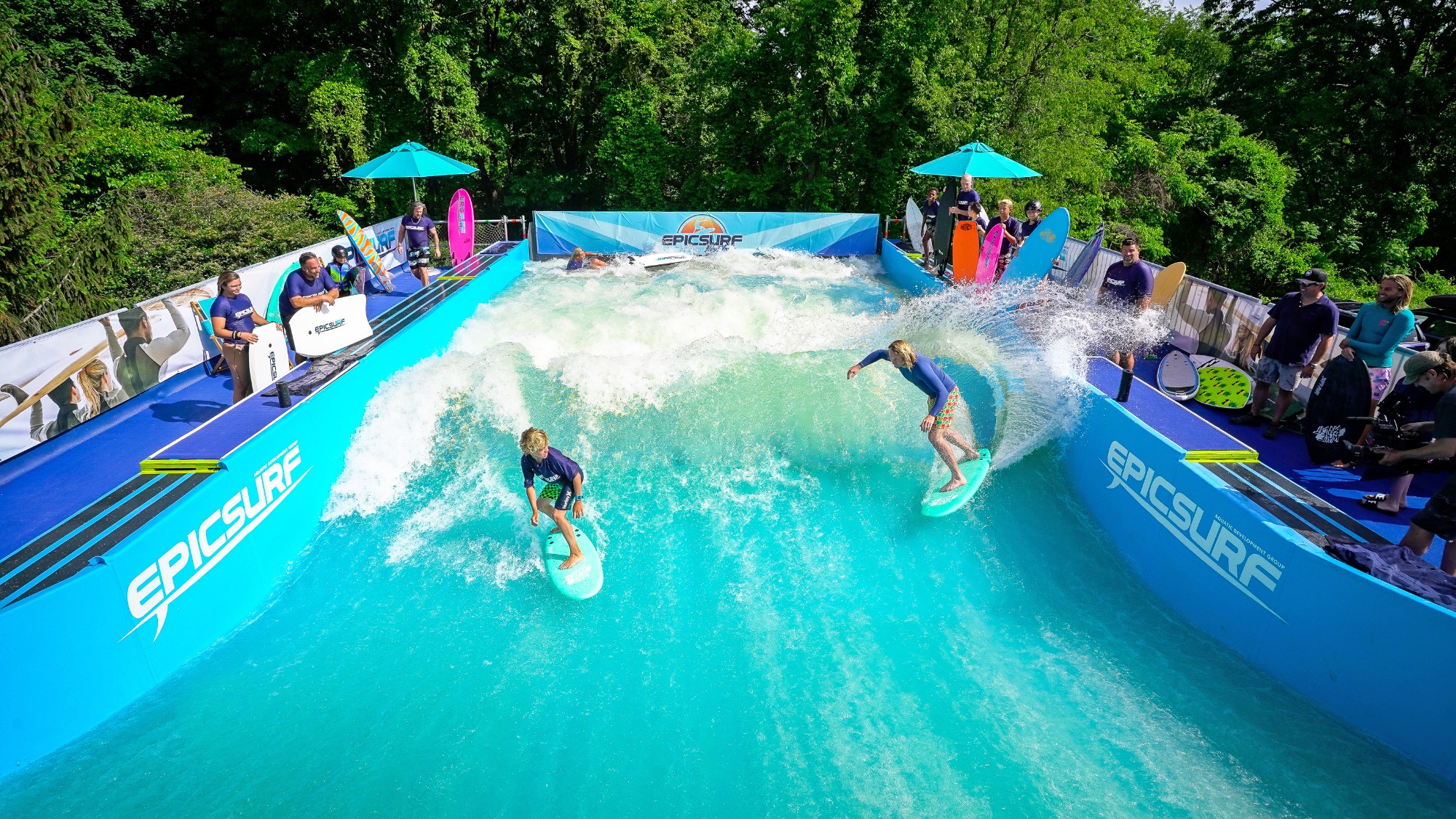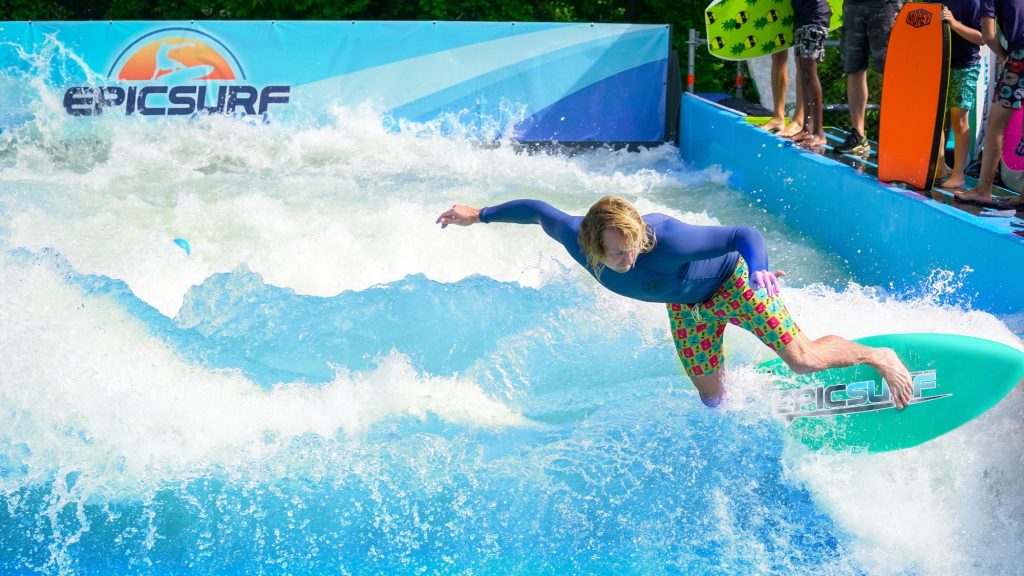The long wave pool history of EpicSurf creators ADG

When landlocked surfer Rick Kane wins a wave pool contest in the 1987 movie, North Shore, his trajectory is as improbable as his inland surf skills. On the podium after his win, he tells the crowd he’s going to the North Shore of Hawaii to ride ocean waves, become a pro surfer and make his dreams come true.
Of course, once Rick lands on the Seven Mile Miracle, he faces innumerable forces against him: not just the power of the pounding waves that draw real-life surfers there, year after year, but the thorny issues of localism, capitalism, and love gone awry. Throwing all manner of salt in his wounds is a North Shore nemesis who spends the movie keeping the Arizona interloper down and out.
Most of the movie’s action takes place on the beaches of Hawaii, complete with sun, sand, and a scantily-clad Nia Peeples. In this world, on this rock, Rick’s dreams might just come to fruition. But in fact, it’s where North Shore begins, in the wave pool in pretend Arizona that surf dreams actually came true. Those scenes were filmed at the Oasis Water Park in Palm Springs, California, which was the world’s first pneumatic wave system designed specifically for surfing.
The pool was a game-changer – and not just for Rick Kane.
“For the industry, those systems that established pneumatics were state of the art,” said Bruce Quay, the Chief Operation Officer for Aquatic Development Group (ADG). ADG designed, built and manufactured the surf wave system for the Oasis Water Park in 1986; it became the first of a generation of artificial surfing waves worldwide. And for ADG, it put them squarely in the heart of wave pool history.
By the late 1980s pneumatic systems, which use valves to push and pull air through an external plenum, were taking hold in recreational water parks across the US thanks to advances in the technology developed by ADG. What ADG did with Oasis, however, was apply that technology to prove that creating real surfing waves was possible in a pool, marrying their know-how in manufacturing with the era’s wave-riding boom. Pneumatics, said Quay, gave them a “tremendous capability of making any number of different waveforms – including large surfing waves.”
There was also the reliability factor. Unlike earlier hydraulic systems, which operate underwater, ADG’s pneumatic system brought the wave-generation system out of the pool. As a result, pneumatic systems lasted longer, were more dependable and were easier to service.
For ADG, which built its first recreational wave systems in the 1970s, the pneumatic system, like the one at Oasis, was the gateway to the company’s future success in surf. In 1988, just one year after Rick Kane paddled onto the big screen, another surf contest played out in an artificial pool. This time, it was the real-life Pro Tour Inland Surf, at the ADG-built Wild Rivers in Irvine, California. The winner of that contest, according to the San Clemente Times, was none other than a 16-year-old Kelly Slater.
ADG’s work in building waves, however, has always been just one part of its business. In its 50-year history, the company has built highly technical wave systems for organizations like the Melbourne Zoo in Australia, the National Zoo in Washington, D.C., and a seal environment for SeaWorld in San Diego, California. Their designs for each were customized to support marine plants and animals. Sea World’s system, for example, had less noise and no equipment in the water, to better simulate the seals’ natural habitat.
Elsewhere, ADG continued building and innovating in the water and surf park space. Since the 1990s, the company has designed & built more than 100 indoor and outdoor water parks and has over 500 wave systems installed throughout the world. Their IP was used to create experiences like Disney’s Typhoon Lagoon in Orlando, Florida (read: two-story body slides, water rafting and a surf pool) and Hurricane Bay at Kentucky Kingdom amusement park (waterfalls, covered waterslides and a family wave lagoon are among its attractions).
Part of the company’s ability to do such bespoke work at scale stems from its dual function as a design house and manufacturer. On its campus in the former mill town of Cohoes, New York, the build side of the business is, quite literally, a short walk from the cubicles where ADG’s engineers and architects sit. For Quay, that’s been both the challenge and the advantage of driving the business forward.
“ADG is really at its best when the two sides…are working hand-in-hand,” he said. “It makes us better because we understand at its core what’s important to be able to build things correctly, on time and on budget – plus the supply chain and the equipment you need as part of it.”
That intimate knowledge of the process as a whole has served ADG well in its water-park work, where Memorial Day– traditionally the last Monday in May, which marks the start of summer in the U.S. – is their perennial project deadline. It’s also positioned them to continue experimenting with new ways to make waves.
“As builders, we started building wave pools and realized, there’s a way to improve these wave generation systems to be more versatile and more dependable,” said Quay.
One of those systems was the FlowRider, a sheet wave experience that has landed in places from Las Vegas, Nevada, to Québec, Canada, which grew out of a partnership with the wave’s inventor Tom Lochtefeld (aka the Godfather of modern surf parks). Starting in 2003, they began refining and manufacturing the system in which participants use a skimboard-style board to maneuver on water and have manufactured and installed more than 125 of these units across North America since its inception.
While ADG has steadily continued its work for recreational water enthusiasts, Hollywood has continued to come calling. From Life of Pi to Master and Commander, the company has created simulated open-ocean waves for a slew of blockbuster movies. The same in-house capability that allows them to meet their Memorial Day deadlines means being agile enough to meet the demands of making water-bound film sets.

More recently, ADG has re-entered the surfing-wave waters with EpicSurf. It’s an adjustable, stationary (or rapid) deep-water wave with heights ranging from three to five feet, for a more ocean-like feeling on the wave and, inevitably, off of it. The development is geared not only toward the would-be Rick Kanes of the world, with pro-surfing stars in their eyes, but also toward the surfing curious.
“EpicSurf grew out of us seeing that there was one missing piece to the whole surf park experience,” said Quay. “and that was the standing wave, the stationary wave: the small footprint, more cost-effective, higher-throughput piece of the park where young kids or even adults who weren’t quite ready to get into the big pool could surf.”
“We call it the ‘everybody surfs’ park model.”
In other words, surf dreams can come true, for all of us. North Shore waves not required.
Related Coverage
